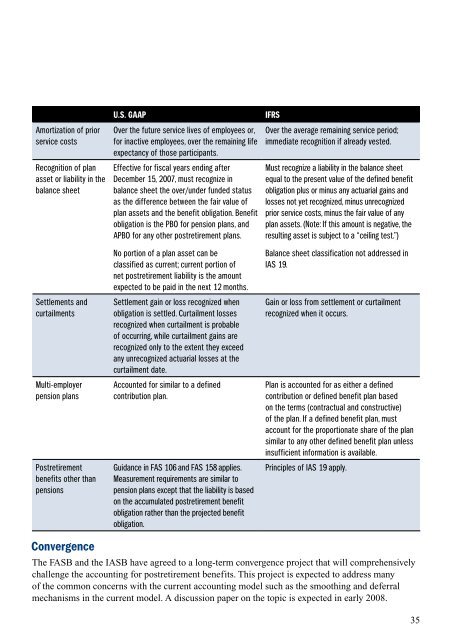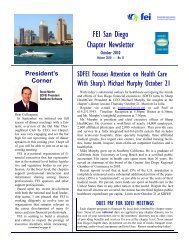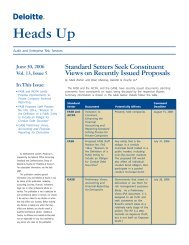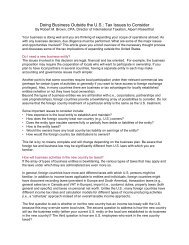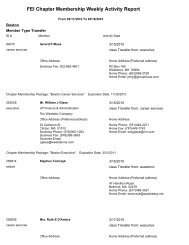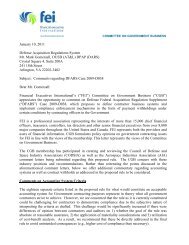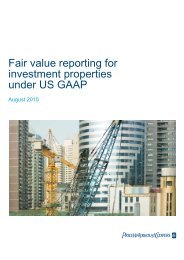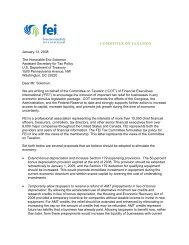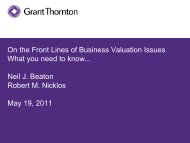U.S. GAAP v. IFRS: The Basics - Financial Executives International
U.S. GAAP v. IFRS: The Basics - Financial Executives International
U.S. GAAP v. IFRS: The Basics - Financial Executives International
Create successful ePaper yourself
Turn your PDF publications into a flip-book with our unique Google optimized e-Paper software.
Amortization of prior<br />
service costs<br />
Recognition of plan<br />
asset or liability in the<br />
balance sheet<br />
Settlements and<br />
curtailments<br />
Multi-employer<br />
pension plans<br />
Postretirement<br />
benefits other than<br />
pensions<br />
Convergence<br />
U.S. <strong>GAAP</strong> <strong>IFRS</strong><br />
Over the future service lives of employees or,<br />
for inactive employees, over the remaining life<br />
expectancy of those participants.<br />
Effective for fiscal years ending after<br />
December 15, 2007, must recognize in<br />
balance sheet the over/under funded status<br />
as the difference between the fair value of<br />
plan assets and the benefit obligation. Benefit<br />
obligation is the PBO for pension plans, and<br />
APBO for any other postretirement plans.<br />
No portion of a plan asset can be<br />
classified as current; current portion of<br />
net postretirement liability is the amount<br />
expected to be paid in the next 12 months.<br />
Settlement gain or loss recognized when<br />
obligation is settled. Curtailment losses<br />
recognized when curtailment is probable<br />
of occurring, while curtailment gains are<br />
recognized only to the extent they exceed<br />
any unrecognized actuarial losses at the<br />
curtailment date.<br />
Accounted for similar to a defined<br />
contribution plan.<br />
Guidance in FAS 106 and FAS 158 applies.<br />
Measurement requirements are similar to<br />
pension plans except that the liability is based<br />
on the accumulated postretirement benefit<br />
obligation rather than the projected benefit<br />
obligation.<br />
Over the average remaining service period;<br />
immediate recognition if already vested.<br />
Must recognize a liability in the balance sheet<br />
equal to the present value of the defined benefit<br />
obligation plus or minus any actuarial gains and<br />
losses not yet recognized, minus unrecognized<br />
prior service costs, minus the fair value of any<br />
plan assets. (Note: If this amount is negative, the<br />
resulting asset is subject to a “ceiling test.”)<br />
Balance sheet classification not addressed in<br />
IAS 19.<br />
Gain or loss from settlement or curtailment<br />
recognized when it occurs.<br />
Plan is accounted for as either a defined<br />
contribution or defined benefit plan based<br />
on the terms (contractual and constructive)<br />
of the plan. If a defined benefit plan, must<br />
account for the proportionate share of the plan<br />
similar to any other defined benefit plan unless<br />
insufficient information is available.<br />
Principles of IAS 19 apply.<br />
<strong>The</strong> FASB and the IASB have agreed to a long-term convergence project that will comprehensively<br />
challenge the accounting for postretirement benefits. This project is expected to address many<br />
of the common concerns with the current accounting model such as the smoothing and deferral<br />
mechanisms in the current model. A discussion paper on the topic is expected in early 2008.<br />
5


